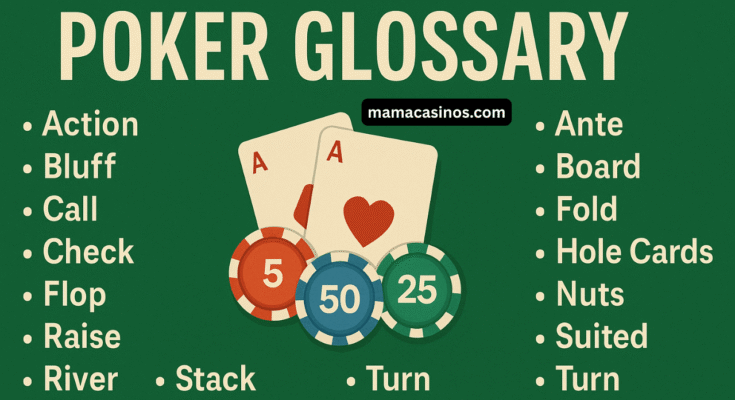A
Action
Anything that involves betting, checking, folding, raising, or calling.
Aggressive Play
Playing style with frequent bets and raises to pressure opponents.
All-In
Betting all your remaining chips.
Ante
A small forced bet every player contributes before cards are dealt.
B
Backdoor
Winning by hitting two perfect cards on the turn AND river (e.g., backdoor flush).
Bad Beat
Losing a hand despite having a strong advantage.
Bankroll
Total money set aside specifically for playing poker.
Big Blind (BB)
Mandatory bet by the second player to the left of the dealer.
Bluff
Betting with a weak hand to make opponents fold.
Board
The community cards on the table.
Button
Dealer position; the best position in poker.
C
Call
Matching the current bet.
Check
Passing the action without betting.
Check-Raise
Checking first, then raising when an opponent bets.
Chip Leader
Player with the highest number of chips.
Cooler
A strong hand beaten by an even stronger hand (unavoidable loss).
D
Dealer (Button)
Position that acts last post-flop.
Deep Stack
Playing with a large number of chips relative to blinds.
Draw
A hand that needs one more card to become strong (e.g., flush draw).
E
Equity
Your mathematical chance of winning a hand.
Expected Value (EV)
Long-term profitability of a decision (+EV = profitable).
F
Fish
Weak/inexperienced player.
Fold
Giving up your hand and any bets you contributed.
Freeroll
A tournament with no entry fee.
G
GTO (Game Theory Optimal)
Mathematically perfect poker strategy resistant to exploitation.
H
Hand Range
A group of possible hands a player might have.
Heads-Up
1v1 poker play.
Hijack
Position two seats right of the button.
I
Implied Odds
Potential money you can win if you hit your draw.
L
Limp
Entering the pot by calling, not raising (often weak strategy).
Loose Player
Someone who plays many hands.
M
Muck
Folded or discarded cards.
Multi-Table Tournament (MTT)
Poker tournament with many tables and players.
N
Nuts
The absolute best possible hand at the moment.
O
Open Raise
The first bet pre-flop.
Outs
Cards that can improve your hand to the winner.
P
Pocket Pair
Both hole cards are the same rank (e.g., 8♠ 8♦).
Pot Odds
Ratio of the current pot to the cost of a call.
Position
Where you sit relative to the dealer; later positions are better.
R
Rake
Small percentage the house takes from each pot.
Range Advantage
One player having stronger overall possible hands.
River
The final community card.
S
Semi-Bluff
Bluffing with a drawing hand that might improve.
Short Stack
Playing with fewer chips relative to blinds.
Slow Play
Playing a strong hand weakly to trap opponents.
T
Tell
A physical or behavioral clue revealing hand strength.
Tilt
Emotional frustration leading to poor play.
Turn
The fourth community card.
V
Value Bet
Bet made to get called by worse hands.
W
Weak-Tight
A player who folds too often and avoids big risks.
⭐ Bonus: Key Pro-Level Concepts
ICM (Independent Chip Model)
Tournament model that calculates the value of chips.
Exploitative Play
A strategy focused on exploiting an opponent’s tendencies.
C-Bet (Continuation Bet)
Betting after being the pre-flop raiser, regardless of hand strength.
Floating
Calling a bet with the intention to bluff later.
3-Bet / 4-Bet / 5-Bet
Re-raises pre-flop in escalating order.




